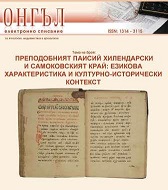Рилският манастир и град Самоков – модели на комуникация
The Rila Monastery and the town of Samokov: Models of communication
Author(s): Konstantin RangochevSubject(s): Anthropology
Published by: Асоциация за антропология, етнология и фолклористика ОНГЬЛ
Summary/Abstract: The paper discusses the models of folklore communication between the town of Samokov and its region and the Rila Monastery, in particular the relations between the metropolitan center Samokov and the Rila Monastery are focused which seem to be very old. There is a legend that after Tsar Ivan Shishman was killed in a battle near Samokov, he “flied” to the Rila Monastery and was buried there. Also, it is said that in the 19th century (in the Ottoman period), the haidut Chakar Voevoda from Samokov received money and weapons from the monastery. Further, the citizens of Samokov donated money to build the ossuary in the monastery and they had the right to bury there their dead. In the 20th century in the period between the two world wars, the newly married couples were expected to visit the monastery on the feast of the Dormition of the Theotokos. Today the young couples also go to the monastery but not necessarily for this Church feast. There are similarities in the altars of the churches in Samokov and of the churches and chapels in the region of the Rila Monastery. It seems that there are structural similarities between the sacred urban space in Samokov and the sacred space in the vicinity of the Rila Monastery. Still, there is no church or chapel in Samokov which are dedicated to St. John of Rila, the patron of the Rila Monastery. However, all the churches in Samokov have his icons placed on their iconostases.
Journal: Електронно списание »Онгъл«
- Issue Year: 2013
- Issue No: 5
- Page Range: 130-147
- Page Count: 18
- Language: Bulgarian

